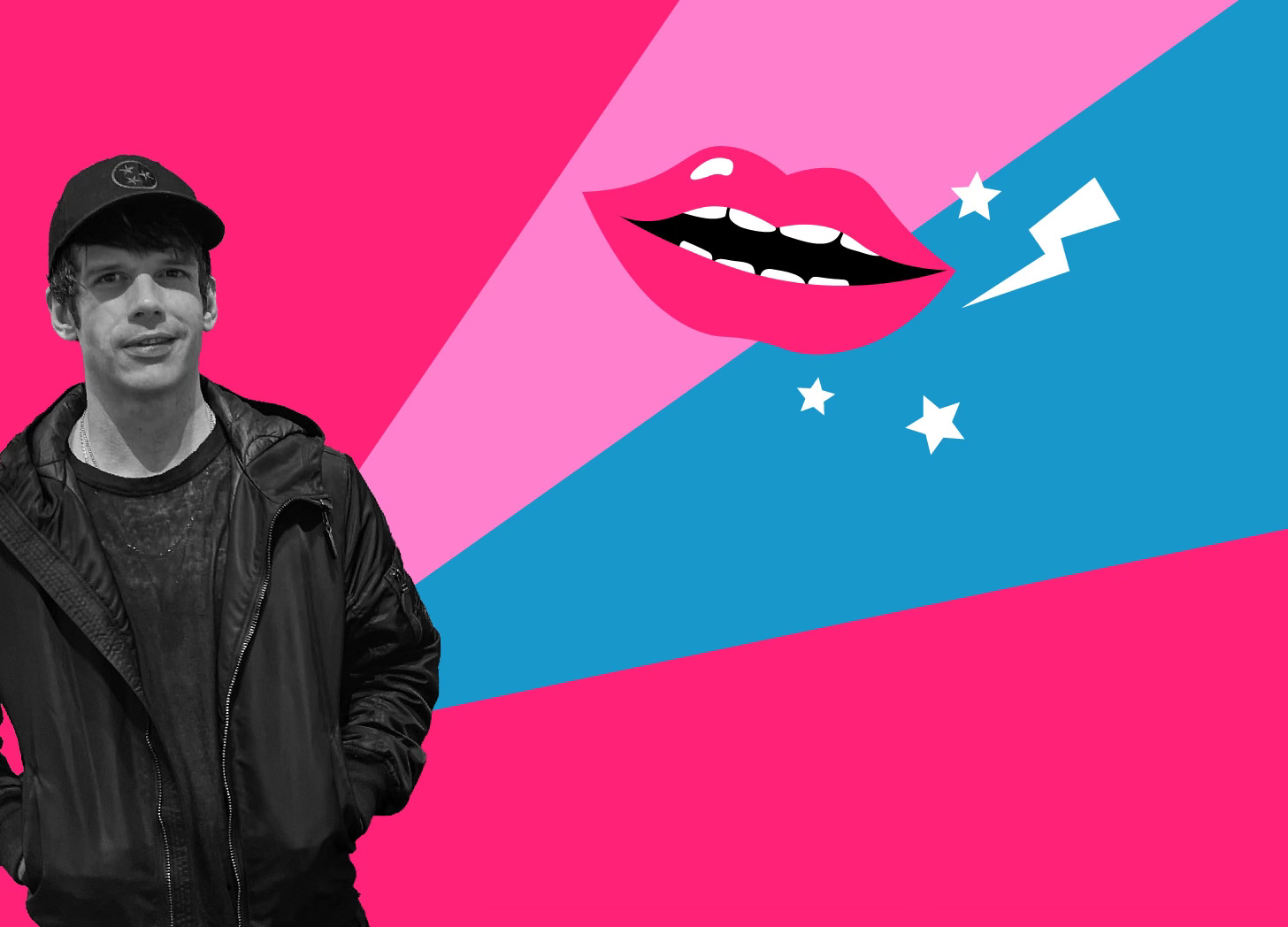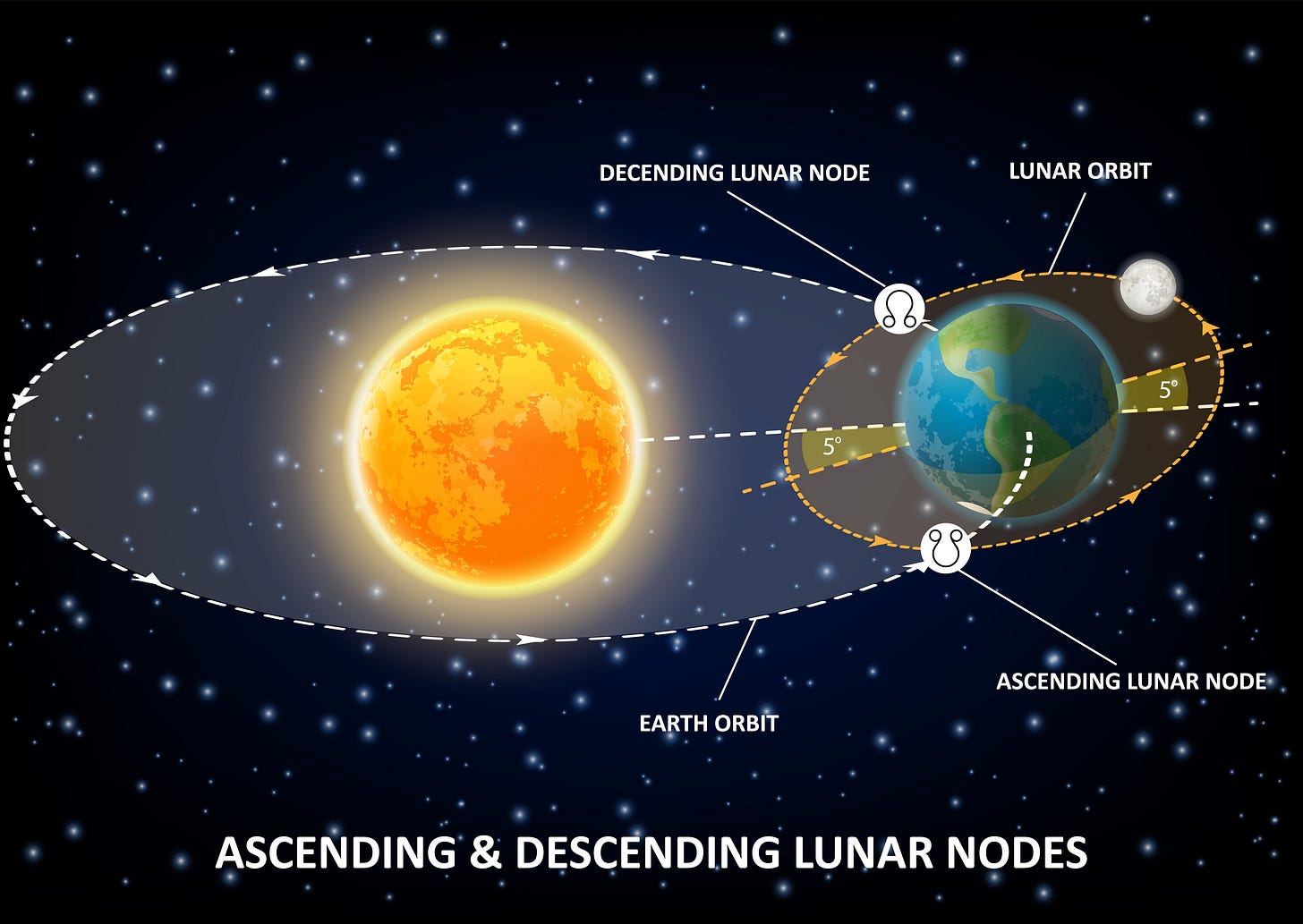The Shadow Grabbers: A Conversation on the Lunar Nodes with Micki Pellerano of Time Lord TV
Exploring Fate, Eclipses, and the Ancient Wisdom of Rahu and Ketu
The lunar nodes are arguably one of modern astrology's most elusive topics. Sometimes called the “nodes of fate,” they’ve been linked to everything from past lives to future potential.
But what exactly are these so-called shadow grabbers, as they’re called in Vedic astrology? Not planets, but mathematical points where the Sun and Moon’s paths intersect. When a lunation strikes this line, an eclipse is born — lights out. A shocking event pre-electricity, and one that still stirs us long past the advent of electric moons.
Historically, before 20th-century astrology reframed them as destiny’s opposing poles, the North Node was generally seen as a “more” button, and the South Node as a “less” button. Jupiter conjunct the South Node? Less luck, fewer lottery wins. Mars on the North Node? More drive, more aggression, more heat.
In Indian tradition, this polarity takes shape through the dragon deities Rahu (North Node) and Ketu (South Node). Picture a severed serpent: Rahu, the insatiable head, cries “More! More! More!” while Ketu, the tail, disperses and releases, saying “Less, less, less.”
This dynamic between Rahu and Ketu was the heart of my recent conversation with dear friend and astrologer Micki Pellerano. In the excerpt that follows, we dive into how these nodes shape the current Virgo–Pisces eclipse season and how they’ve been understood across history and in practice.
Vivi Henriette: Maybe we should start with the nodes themselves. How do you view them both in a birth chart and in the mundane world?
Micki Pellerano: Well, in the mundane world, it's just that really…the North Node is where the Moon scoops upward in its trajectory, and the South Node is where it dips downward. In the birth chart, I’m grateful for my training in Vedic Astrology, because it really filled in a lot of blanks… The best way to explain the nodes is maybe metaphysically, because there is a spiritual dimension to reality. Astrology is a technique of observing reality through that plane.
In Vedic tradition, Rahu (North Node) represents our attachment to matter, to the material world. We’re all born because of Rahu, because it ties us to incarnation. In contrast, Ketu (South Node) dissipates matter. A body without a head doesn’t have individual consciousness — it dissolves individuality. So Rahu concentrates desire and attachment, while Ketu disperses and renounces.
Vh: I'm thinking about my own experience. I have Moon pretty close to Rahu, within three degrees. It doesn't feel so easy, right? If you think about the moon as being this fragile human, — maybe most human part of us — like having a node there is a lot. People will look at my chart and be like, “That's awesome.” Is it?
MP: Yeah, Moon Rahul will destabilize the emotions around that. Freedom Cole is really great with everything, of course, but, but he's really good with the psychological, psychiatric implications of astrology. He points out that Moon-Rahu will give a disorganized attachment style. The moon is how we attach to others. It's how we relate emotionally with other people.
Venus is what we're attracted to. The moon is what we're attached to emotionally. So, Rahu will give a disorganized attachment style. Mars will give an anxious attachment style. Saturn will give an avoidant attachment style….An analysis of the moon and the fourth house will give you somebody's attachment style, hands down.
Vh: You talked about Rahu or the North Node as this material hunger or what entices us to this material world — which is important because we're people who live in a material world. Can you talk a little bit about Ketu or the south node?
MP: Yeah, so you know, Rahu wants to party with us, right? We have serpent imagery there. In Vedic Astrology, it's the head of the demon and the tail of the demon — the disembodied head of the demon and the headless body of the demon. In the Arabic speaking world, and also European astrology, Rahu north node is the head of the dragon and Ketu is the tail of the dragon.
In Eden, we have a lot of serpent references there too…in the book of Genesis, it's like, “Oh, wouldn't you like to know the world of duality? Wouldn't you like to know the world of opposites?” Which is the binary world of matter.
And so Adam and Eve, they’re tempted to bite the apple and eat it. And then they're cast out of this celestial, divine existence into that dual material realm. Adam and Eve see that they are naked once they bite the apple, which means that they see that there's a difference between them; that there's a polarity, sexual polarity, between a male and female. They didn't know that before. They weren't in the realm of opposites or duality. They were in a realm beyond that.
Rahu is what draws us into that, to that dual world, and Ketu is the opposite. Ketu is not interested in materiality. Ketu wants to dissipate and disperse matter. If we have a body without a head, then we don't have an individual consciousness. We don't have a consciousness of separated identity.
ABOUT MICKI
Micki Pellerano is a Cuban-American artist and occultist whose practices have established a preeminent career in Hellenistic and Vedic astrology. His work combines elements of diverse media, as well as ritual symbolism derived from both Eastern and Western esotericism. His practice known for its predictive accuracy and remedial approach is maintained alongside frequent writings and presentations on art and metaphysical topics. He teaches astrology on several platforms and is host of the program Time Lord TV.
ABOUT VIVI
Vivi Henriette is an LA-based astrologer and tarot reader whose collaborative approach to divination weaves in storytelling and mythology to create a container for her clients to explore their personal narrative. She’s the host of the Los Angeles Astro Salon at the Philosophical Research Society and the podcast TALKTALKTALK and producer ofLA Astro Fest.
FOLLOW ART of the ZODIAC & Vivi Henriette on INSTAGRAM +YOUTUBE+SPOTIFY for the latest TALKTALKTALK





